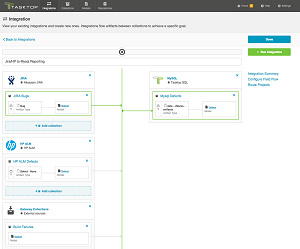News
New Tasktop Tool Scales Agile, DevOps Integrations
- By David Ramel
- February 1, 2017
Tasktop Technologies Inc. combined several of its software development and delivery products into a new suite that it says takes a different approach to integrating enterprise agile and DevOps initiatives.
Announced yesterday, the Tasktop Integration Hub is designed to harness all of an organization's development and delivery tools, workflows and integrations into one tool that can scale as needed.
This scaling capability is especially important as methodologies such as agile and DevOps have transformed enterprise software development, the company said. One aspect of that transformation is the shift from single, inclusive platforms to disaggregated best-of-breed tools from multiple sources.
While integrating just a few disparate tools is relatively simple, the interrelationships and integration problems become much more complex as the number of tools increases, which Tasktop said is a recent industry trend.
"In prior decades, the way to succeed with new methodologies involved betting on the right platform," said Tasktop CEO Mik Kersten in a blog post yesterday. "But in the world of agile and DevOps, there is no one platform. Instead, we are witnessing a large-scale disaggregation of the tool chain towards the best-of-breed solutions. For large-scale agile and DevOps transformations to succeed, we must shift our thinking from end-to-end platform to tool chain modularity."
 [Click on image for larger view.]
Integration Hub Overview (source: Tasktop)
[Click on image for larger view.]
Integration Hub Overview (source: Tasktop)
To that end, the new integration hub combines tools that were previously offered independently, including Tasktop Sync (an integration server), Data (a data repository for near real-time analytics) and Gateway (an integration tool for connecting DevOps tools to the software lifecycle).
The integration hub introduces the concept of model-based integration that helps disparate tools work together, something that becomes more problematic as the number of tools increases. Tasktop used the metaphor of language translation to illustrate this concept. Whereas translating a document from Spanish to French and vice versa is relatively easy, translating a bunch of languages into all of the other languages is much more difficult. In the model-based approach, this becomes easier, as a language is first translated into a model -- a kind of universal language, like English, for example -- and then that single model is translated into all the other languages.
"For example, user stories, defects and support ticket models are defined in Tasktop, and then can be easily mapped across dozens of different projects and tools," Kersten said.
 [Click on image for larger view.]
Integration Hub in Action (source: Tasktop)
[Click on image for larger view.]
Integration Hub in Action (source: Tasktop)
Tasktop said its approach enables organizations to grow their software deployments to the scale of hundreds of projects, tens of thousands of users and millions of artifacts -- such as tasks, defects and requirements -- without the need to write any code.
In addition to the model-based integration, other features of the new offering highlighted by the company include:
- Support for applying different styles of integration across tools. For example, agile and ITSM tools can be integrated for defect/ticket unification then easily connected to a database for instant Mean Time to Resolution (MTTR) metrics.
- Easy scaling across hundreds of projects. By defining models that span projects and tools, new projects can be on-boarded easily and connected to the value stream.
- All integrations work all of the time via Tasktop's Integration Factory. Multiple versions of the same tool can be connected, along with old versions of legacy tools and the frequently updated APIs of Software-as-a-Service (SaaS) tools, without breaking because Tasktop tests all version combinations. Currently, Tasktop supports 51 tools and 364 versions.
Tasktop said its integration hub, which has been under development for three years and available as a limited release for about 10 months, is now generally available.
"As organizations transform into digital businesses, the agile and DevOps movements powering those transformations start to fail once they are deployed to hundreds and thousands of IT staff," the company said in a statement yesterday. "The best-of-breed tools that make start-ups successful were not designed to work together at this scale, resulting in duplicate entry, a lack of visibility, cost overruns and compliance exposure. Point-to-point integrations, Enterprise Services Buses and in-house approaches cannot solve the problem as they become prohibitively expensive to maintain due to the countless tools and versions that make up the modern tool chain.
"Tasktop serves as a Value Stream Integration platform, the first of its kind, providing organizations with an enterprise-grade backbone that flows information in real time across all of the people, processes and tools involved in software delivery."
About the Author
David Ramel is an editor and writer at Converge 360.